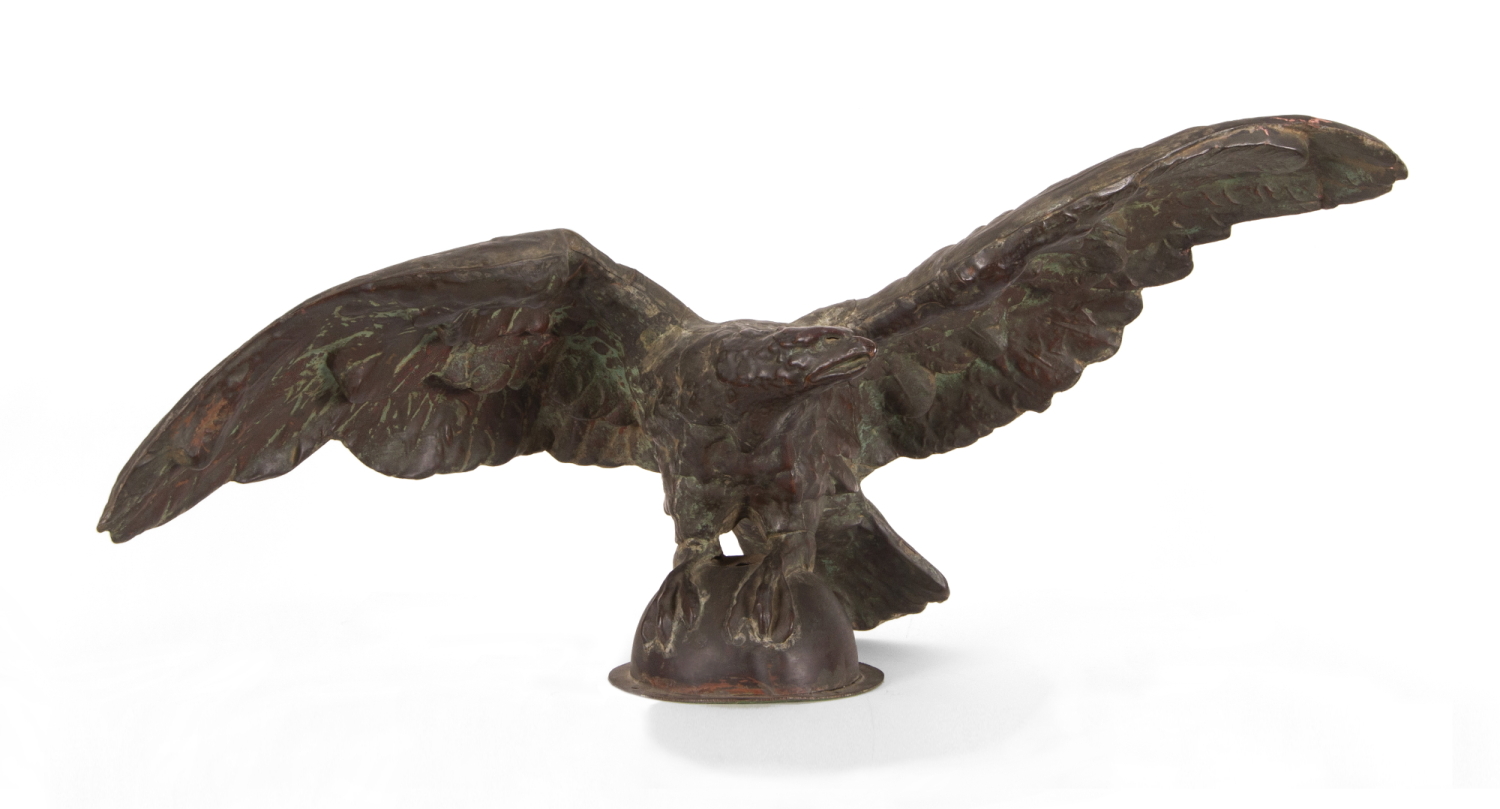
| |
PILOT HOUSE / TRADE EAGLE ON A HALF-GLOBE PERCH, HAND-MADE OF MOLDED COPPER, LIKELY ON AN IRON FRAMEWORK, circa 1860-1890 |
| |
|
| Dimensions (inches): |
16" tall x 38" wide x 14.5"deep |
| Description: |
|
Molded copper eagle with a sweeping, spread winged form and head facing to its proper left, perched on a half-globe mount. Unlike most weathervanes that may seem similar at first glance, light in weight, so they could more freely spin, this figure is heavy and substantial, likely constructed about an iron framework. The term “pilot house eagle” probably rolls off the tongue of collectors and observers in the antiques marketplace a bit too loosely. Those seen mounted on the bridge or pilot house for decoration were sometimes mounted higher, on the mast. If made of metal, such as this example, they could be employed as lightening arrestors. Two eagle finials (non-matching pairs, one upright, one stooped), can be seen atop the masts of both the Hudson River steamer James W. Baldwin and the Sylvan Dell, in surviving illustrations.
Eagles such as this could be acquired from manufacturers of decorative metals, such as J.W. Fiske in New York, or Harris & Company in Boston. Maker W.H. Mullins of Salem, Ohio (est. 1882) illustrated examples similar to this one in his 1891 catalogue. Though none match precisely, the construction is notedly similar to that of this figure, and was probably standard fare for large copper forms that were not weathervanes. Two of those pictured by Mullins, one entitled “Centennial Eagle” and the other “Trade Eagle,” are described as being available with head facing right, left, or forward, with or without a half-sphere mount. When examining the composition of this particular figure, and with this knowledge at hand, one can better understand why the head is applied in the way that it is, instead of being molded can grow lightly with the surrounding neck. The method of manufacture allowed customization of the form to the desires of the buyer, for a myriad of possible uses. A hole in the top of the half sphere probably allowed for the insertion of either a grounding rod or perhaps a wick. A New York maker of hammered brass eagles made them so that an oil reservoir could be added with a wick, for use as an illuminated finial on the staff of a parade banner. Many parades of the 19th century were torch-lit, occurring at night, after the workday. In the interest of weight, the iron framework was probably eliminated in such instances.
The surface of the copper, patinated from both age and obvious, long-term use, dark and weathered, is extremely appealing. Though wonderful when viewed head-on, the form gets better and better as it is raised and is most stunning when placed above head-height. Presentation on top of a tall cupboard or highboy, or on a wall wedge above a flag, is outstanding.
Condition: Various dents and abrasions from obvious long-term use and exposure to the elements. Some minor separations of seams, though with no ill-affect to stability. |
|
|
| |
|
| Primary Color: |
brown, copper |
|
| Earliest Date: |
1860 |
|
| Latest Date: |
1890's |
|
| For Sale Status: |
Available |
|
| Price |
please call or email |
|
| E-mail: |
info@jeffbridgman.com |
|
 |
|
Page Views:... 1348 |
|


